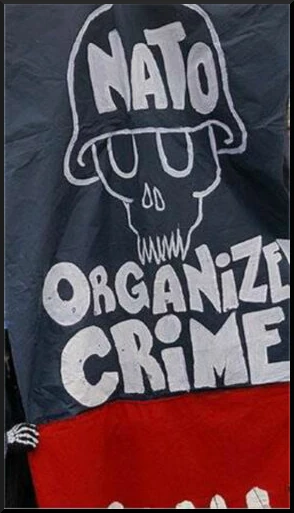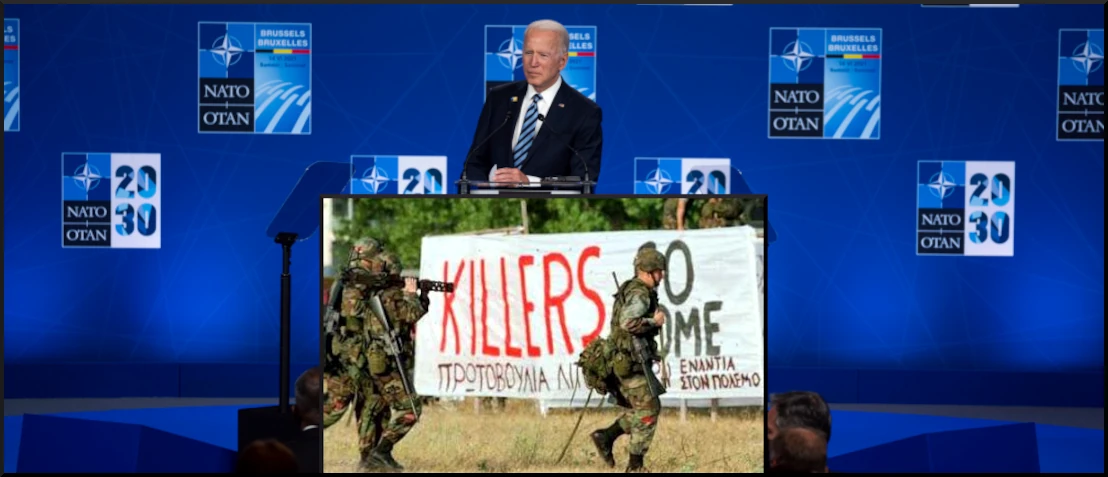by John Catalinotto, published on Workers World, December 22, 2021
Washington has threatened economic and diplomatic sanctions against Russia over the conflict with Ukraine and has raised the possibility of military action. In an interview with Fox News Dec. 7, Mississippi Republican Senator Roger Wicker even discussed U.S. troop intervention and a nuclear first strike!
 Moscow countered with a series of demands on the U.S. government and the NATO military alliance. These demands would prevent NATO’s further military penetration toward the Russian border and stop NATO from absorbing other states in Eastern Europe and the Caucasus region. Some of these countries border Russia or were part of the Soviet Union before 1991.
Moscow countered with a series of demands on the U.S. government and the NATO military alliance. These demands would prevent NATO’s further military penetration toward the Russian border and stop NATO from absorbing other states in Eastern Europe and the Caucasus region. Some of these countries border Russia or were part of the Soviet Union before 1991.
NATO is an aggressive military alliance under U.S. leadership. Since the collapse of the Soviet Union and the Warsaw Pact in the early 1990s, the U.S. has mobilized its imperialist allies within NATO behind its attempt to reconquer former colonial countries worldwide. These countries had won some sovereignty when the Soviet Union existed; examples include Yugoslavia, Afghanistan and Libya.
NATO has absorbed some former Warsaw Pact members and Soviet republics that have become Western imperialism’s neocolonies. NATO uses these countries’ troops as potential cannon fodder and their territory for missile bases aimed at Russia.
Unlike the Soviet Union, Russia is a capitalist country. Russia no longer provides a model of potential socialist development that by its very existence threatens capitalist exploitation. Nevertheless, the U.S. and its allies have applied sanctions and military pressure to prevent Russia from becoming a competitive capitalist rival.
U.S. use of NATO
Washington keeps its Western European imperialist allies lined up behind NATO’s military leaders, who have always been U.S. generals. Last spring’s NATO war exercises sent troops and tanks from dozens of countries toward the Russian border.
Republican Party leaders like Ricker have made the most aggressive anti-Russia statements and criticized President Joe Biden for being soft on Russian President Vladimir Putin. Despite the Republican rhetoric, U.S. aggressive foreign policy has been and is bipartisan. Both Republican and Democratic Party leaders fully back U.S. imperialism and militarism — the $768 billion military budget proves it.
Regarding Ukraine, the Democratic administration orchestrated the coup that overthrew an elected president and installed a rightist, anti-Russian regime in 2014. Then-Vice President Biden was involved. And Ukraine’s racist and fascist elements played a role in the U.S.-backed coup.
The coup was really a successful maneuver to divide Ukrainians and Russians using right-wing nationalist ideology. In February 2014, the new ultraright Ukraine government threatened the rights of the Russian-speaking residents, including the right to use their language.
The new Ukraine regime virtually forced Russia to annex Crimea, a peninsula jutting into the Black Sea that housed the Russian fleet. Control of Crimea province had been shifted from Russia to Ukraine in 1954. Then it meant little, as the Soviet armed forces kept the use of Crimea’s vital naval base, something the Russian government had no intention of giving up.
The population of Crimea — like that of the Donbass region in eastern Ukraine — was predominantly Russian-speaking and identified more with Russia than Ukraine. In a referendum, the Crimean population supported the Russian takeover. The population of two regions of the Donbass, Donetsk and Lugansk, chose to secede from Ukraine, and the central government waged war on them. This battle has recently heated up.
Drone strike in Donbass
Ukraine opened a war on the new Donbass countries, which was muted by an agreement signed in Minsk, Belarus, in September 2014, that set terms for a ceasefire. In October this year Ukraine launched a missile from a drone that hit the artillery base of the forces defending the pro-Russian regions.
Ukrainian generals have stated that their army is incapable of confronting Russia’s, and they have asked for additional military help from NATO.
In response to the growing threat that the Kiev regime would assault the Donbass region, Russia has mobilized troops near Ukraine.
In a diplomatic initiative, Putin demanded on Dec. 17 that NATO countries withdraw the 2008 invitation to Ukraine and Georgia to join NATO and that NATO deploy no offensive weapons in states neighboring Russia. Putin held a well-publicized and friendly video conference with Chinese President Xi Jinping Dec. 15 underlining their common interests.
The NATO leaders have so far rejected these reasonable Russian demands. There are signs that the Biden administration will use any tension with Russia to impose sanctions on Russia and demand a stoppage of the Nord Stream 2 natural gas pipeline from Russia to Germany.
Antiwar forces in the United States can confront increased tension by taking public positions and mobilizing protests to demand NATO’s immediate withdrawal from Eastern Europe — and the rapid dissolution of this aggressive military alliance.
John Catalinotto was born in New York, USA, where he teaches mathematics at City University. He was a civilian organizer for the anti-war, anti-racist American Servicemen’s Union during the U.S. war in Vietnam, since 1982 managing editor of Workers World weekly newspaper, key organizer for the International Action Center of the Tribunal on Yugoslavia (June 2000) and Tribunal on Iraq (August 2004). Collaborator with Avante and odiario.info (Portugal) and Terra e Tempo (Galicia). Edited two books, Metal of Dishonor about depleted uranium (1997) and Hidden Agenda: the U.S.-NATO Takeover of Yugoslavia (2002). Member of Tlaxcala.
